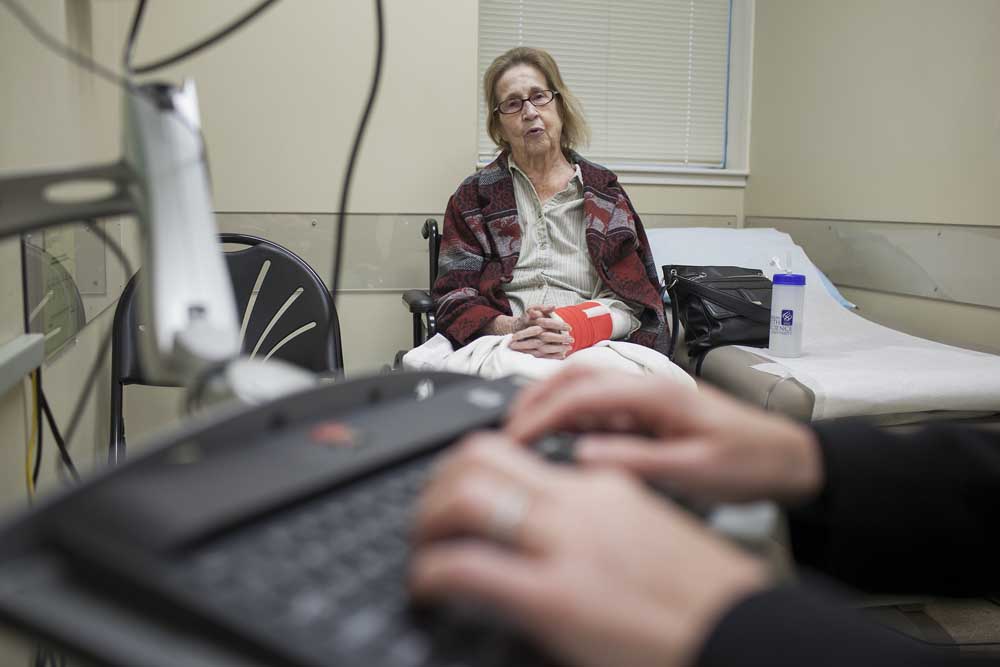An aging population, but few geriatricians
Published 12:00 am Tuesday, January 26, 2016

- Carl Kiilsgaard / The New York TimesRuth Miles at an appointment with Dr. Elizabeth Eckstrom, a geriatrician, at the Oregon Health & Science University Hospital in Portland last year. With roughly 31 million Americans set to turn 75 by 2030, there is an extreme shortage of geriatricians.
PORTLAND — Ruth Miles, 83, sat in a wheelchair in a small exam room, clutching a water bottle, looking frightened and uncomfortable.
Trending
She was submitting to the tender scrutiny of Dr. Elizabeth Eckstrom, who scooted her stool so close she was knee to knee with her patient.
Miles had broken her pelvis after tripping on an electric cord in her apartment. The weeks since then had been hellish, she told her doctor. At the rehab center, incapacitated and humiliated, she had cried for help from the bathroom. Her hands were covered with bruises from the blood thinners she was on. She winced as Eckstrom tugged slightly at a bandage that adhered stubbornly to her left elbow. “We’ll have to get that changed,” Eckstrom said softly.
Eckstrom, 51, who spends her days focused on the complex medical needs of older patients, is, like the Central African okapi, a species that is revered, rare and endangered. She is a geriatrician.
Trending
Geriatrics is one of the few medical specialties in the United States that is contracting even as the need increases, ranking at the bottom of the list of specialties that internal medicine residents choose to pursue.
“One of the greatest stories of the 20th century was that we doubled the life expectancy of adults,” said Terry Fulmer, president of the John Hartford Foundation, which funds programs to improve the care of older adults. “Now we need to make sure we have all the supports in place to assure not just a long life but a high quality of that long life.”
Here in Oregon, there is approximately one geriatrician for every 3,000 people older than 75. The shortage will grow more acute as the state’s population continues to age.
Oregon’s problem is mirrored across the United States. According to projections based on census data, by the year 2030, roughly 31 million Americans will be older than 75, the largest such population in American history. There are about 7,000 geriatricians in practice today in the United States. The American Geriatrics Society estimates that to meet the demand, medical schools would have to train at least 6,250 additional geriatricians between now and 2030, or about 450 more a year than the current rate.
An unpopular field
Yet, the field is becoming even less popular among physicians in training. Oregon Health & Science University, where Eckstrom practices, had five slots open for geriatrics fellows for 2016 and filled only three.
Last year, Dr. Elizabeth White-Chu, who directs the university’s geriatrics fellowship program, said she had resorted to cold-calling residency programs throughout the Northwest in search of candidates. This year, there were so many unfilled slots around the country that White-Chu did not even bother to call. “It would have been a total waste of time.”
A geriatrician is a physician already certified in internal or family medicine who has completed additional training in the care of older adults. In addition to providing clinical care, geriatricians are skilled in navigating the labyrinth of psychological and social problems that often arise in the aging population.
“Part of the reason aging has such a negative connotation is this sense that you can’t cure older people’s problems,” said Dr. Kenneth Brummel-Smith, a professor of geriatrics at Florida State University College of Medicine in Tallahassee, Florida, a state with a particularly severe geriatrician shortage. “And yet a good geriatrician can bring someone back to functional status.”
People avoid the field for understandable reasons. Geriatrics is among the lowest-paying specialties in medicine. According to the Medical Group Management Association, in 2014, the median yearly salary of a geriatrician in private practice was $220,000, less than half a cardiologist’s income. Although geriatrics requires an extra year or two of training beyond that of a general internist, the salary for geriatricians is nearly $20,000 less.
Since the health care of older patients is covered mostly by Medicare, the federal insurance program’s low reimbursement rates make sustaining a geriatric practice difficult, many in the field say.
“Medicare disadvantages geriatricians at every turn, paying whatever is asked for medications and procedures, but a pittance for tough care-planning,” said Dr. Joanne Lynn, a geriatrician and the director of the Center for Elder Care and Advanced Illness at Altarum Institute, a nonprofit health systems research organization based in Ann Arbor, Michigan.
A debate on necessity
Some primary care physicians argue that geriatricians are unnecessary, that most ailments among older adults are the same as those that hit the middle-aged population, such as diabetes, hypertension and heart disease. The difference, they say, is that older patients just have more of them.
“This is simply untrue,” Eckstrom said. “Just think about dementia, or delirium caused by a medication. Those are just two conditions you seldom see in middle-aged adults.”
Eckstrom embodies both the frustration and gratification that characterize a geriatrician’s day. She spent most of her 40 minutes with Miles sweeping up after the caregivers who had preceded her: pressure ulcers, a wound dressed poorly, dehydration, depression.
She gave her patient a pep talk, urging her to be up and walking as much as possible, and to take in more fluids. She commented on her patient’s brightly colored shoes. Throughout the morning, in fact, she made a point of admiring something each patient was wearing: a bright piece of jewelry, a colorful scarf, an all-purple outfit.
Then, as if Miles were doing her doctor a personal favor, Eckstrom added, “I very much appreciate that you’re not taking too much of the oxycodone.”
At the end of the appointment, Eckstrom took Miles’ hand and said, “You can always call me.”
“You’re too busy,” Miles said.
“I’ll squeeze you in. I’ll make it work.”
Miles had arrived at her appointment defeated and anxious. By the end, she was relaxed, even animated.
“I know how lucky I am to have her,” she said as a nurse carefully removed the bandage on her elbow and replaced it with one that would not stick to the wound.
Eckstrom was a general internist who practiced in primary care for nine years before returning to OHSU to complete a geriatrics fellowship. “I thought I was doing a good job caring for my patients,” she said. “But I wanted to do more geriatrics teaching and research.” The fellowship opened her eyes. “I had no idea what I didn’t know,” she said.
Phyllis Wolfe, 76, has been seeing Eckstrom for more than 12 years. Two years ago, she had a series of mini-strokes that affected her memory. Then she developed two small-bowel obstructions, and each surgery was followed by significant cognitive decline and delirium. Her gait was unsteady, and she was in danger of falling.
Wolfe’s health gradually improved not by virtue of drastic interventions, but from careful attention to every possible detail. Eckstrom stopped Wolfe’s prescription for Ambien, an insomnia drug that can cause confusion in older patients. Eckstrom also suggested an exercise program to prevent a fall, and put Wolfe on a nutrition plan.
In Eckstrom’s office that day, Wolfe was transformed — lively and clearheaded. “If you hadn’t seen her six months ago, you’d never know she had all those problems,” Eckstrom said.
‘Sick of the whining’
While many in geriatrics have resigned themselves to their predicament, some believe the field will soon receive the recognition it deserves. New payment models that hold doctors and health systems accountable for keeping people healthy are on the rise, and geriatricians foresee a day when they are better valued and compensated.
“A lot of us are sick of the whining,” said Dr. Rosanne Leipzig, a geriatrician and professor at the Icahn School of Medicine at Mount Sinai, which is experimenting with a two-year program that combines geriatrics and palliative care.
And there is an emerging emphasis on training many different health care professionals — nurses, pharmacists, internal and family medicine physicians, physician assistants, and physical and occupational therapists — to see older patients through a geriatrics lens rather than focusing solely on creating more geriatricians. Mini-fellowships at teaching hospitals to train practicing physicians in geriatrics have sprung up around the country. Cardiology, urology, emergency medicine and other specialties are promoting geriatrics training and research within those disciplines.
Acknowledging an older person’s need for dignity is an important part of Eckstrom’s practice. When talking with a patient about giving up driving, she refers to it as “retiring from driving,” casting it as an act of liberation, as if driving were a job to be freed of.
It is that kind of perspective that drew the attention of trainees already attracted to the human side of medicine. Dr. Kathleen Drago grew to love geriatrics while training under Eckstrom. “I got caught in Elizabeth’s web,” she said. “You meet people who have walked these incredible paths, and are starting to reflect on their lives and focus in on what’s important in the time they have left.”









